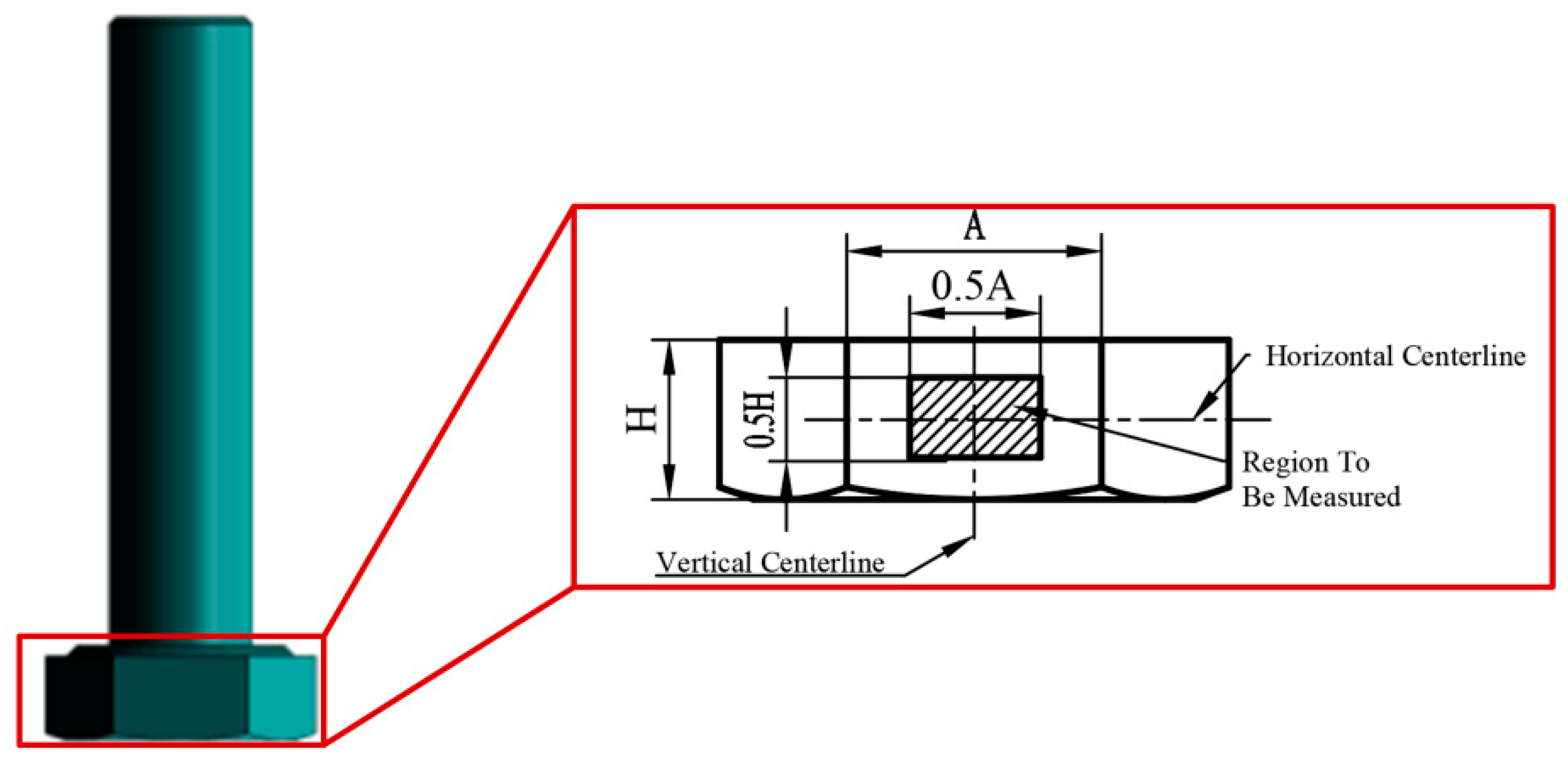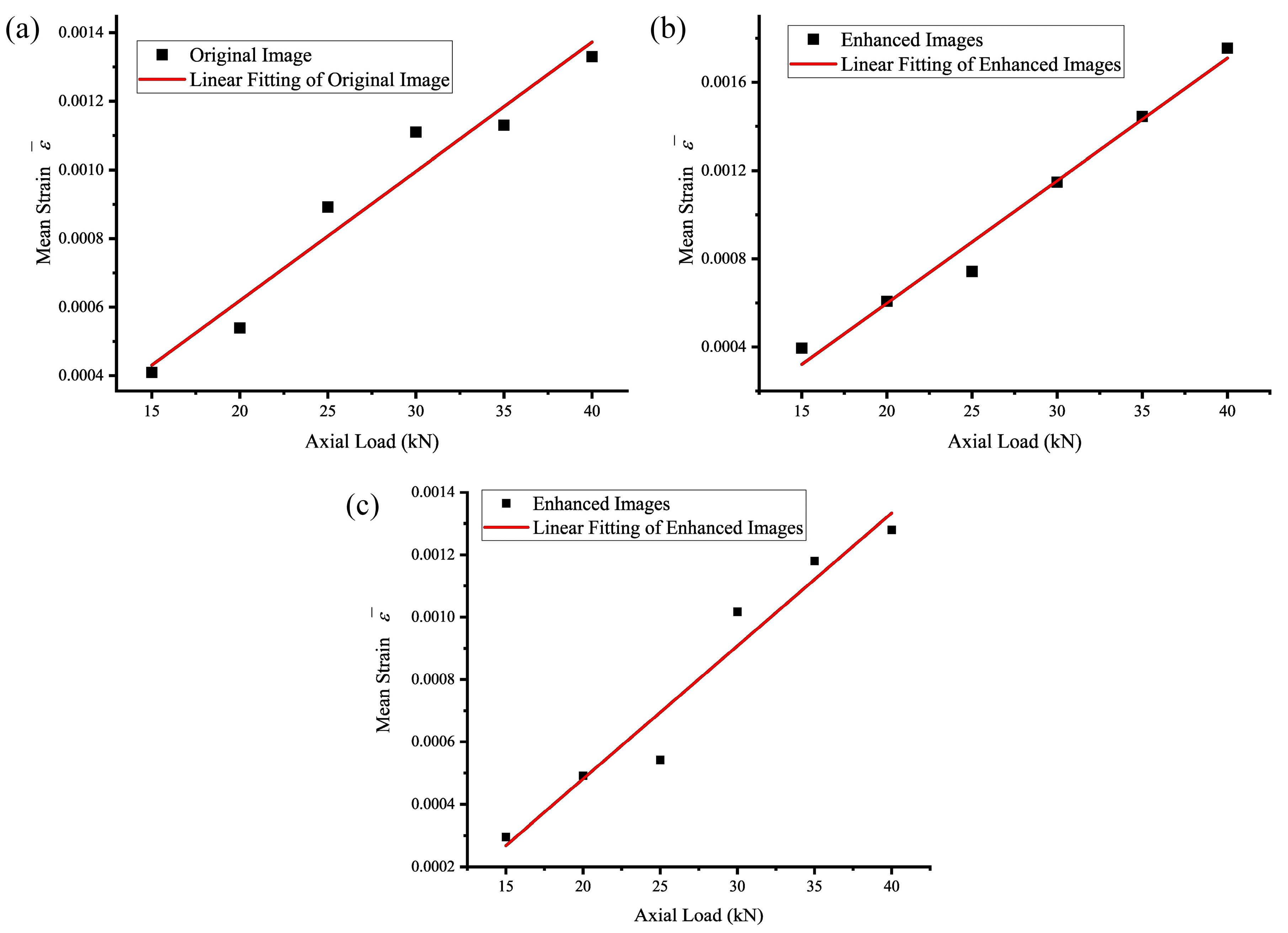Early Bolt Loosening Detection Method Based on Digital Image Correlation
Abstract
1. Introduction
2. Theoretical Background and Signal Processing
2.1. Principles of DIC Technology
2.2. Analysis and Solutions of Influencing Factors in Strain Detection Based on DIC Method
2.2.1. Correlation Loss
2.2.2. Imaging Noise
2.2.3. Light Intensity
2.3. Regional Selection
3. Experiment
3.1. Experimental Setup
3.2. Experimental Details
3.3. Study on the Effect of Light Intensity
3.4. Early Bolt Loosening Assessment Procedures
4. Results and Discussion
4.1. Results
4.2. Experimental Results on Light Intensity Investigation
4.3. Method Validation
5. Conclusions
- (1)
- A research method for detecting bolt loosening based on DIC is proposed by using digital image processing techniques and analyzing small deformations on the object’s surface. To the best of the authors’ knowledge, this is the first application of the DIC method to detect strain on the side of the bolt head and establish a relationship model between this strain and the axial load to achieve the non-contact detection of early bolt loosening.
- (2)
- There is a good linear relationship between the mean strain in the central region of the side of the bolt head and the axial force of the bolt, allowing for the prediction of axial force based on this mean strain. In the verification experiment, the maximum relative mean error in predicting axial force based on this mean strain does not exceed 11%.
- (3)
- Retinex image enhancement processing reduced the standard deviation of the intercept and slope of the mean strain versus axial tension fit in the lateral center region of the bolt head by 10.56% and 10.32%, respectively, improving its linearity.
Author Contributions
Funding
Institutional Review Board Statement
Informed Consent Statement
Data Availability Statement
Acknowledgments
Conflicts of Interest
References
- Chen, L.; Jiang, Y.; Huang, L.; Zeng, L. Real-time monitoring method of bolt loosening with clearance evolution law of joint surface. Mech. Sci. Technol. 2023, 34. [Google Scholar] [CrossRef]
- Fierro, G.P.M.; Meo, M. Structural health monitoring of the loosening in a multi-bolt structure using linear and modulated nonlinear ultrasound acoustic moments approach. Struct. Health Monit. 2018, 17, 1349–1364. [Google Scholar]
- Kitazawa, S.; Lee, Y.; Patel, R. Noncontact measurement of bolt axial force in tightening processes using scattered laser ultrasonic waves. Ndt E Int. 2023, 137, 102838. [Google Scholar]
- Wu, Z.; Guo, T.; An, Z.; He, Y. Axial force detection based on electromagnetic ultrasonic of power bolt. J. Phys. Conf. Ser. 2023, 2474, 012049. [Google Scholar]
- Pucillo, G.P.; Carrabs, A.; Cuomo, S.; Elliott, A.; Meo, M. Cold expansion of rail-end-bolt holes: Finite element predictions and experimental validation by DIC and strain gauges. Int. J. Fatigue 2021, 149, 106275. [Google Scholar]
- Du, J.G.; Qiu, Y.Y.; Wang, Z.Q.; Li, J.; Wang, H.D.; Wang, Z.X.; Zhang, J.Y. A three-stage criterion to reveal the bolt self-loosening mechanism under random vibration by strain detection. Eng. Fail. Anal. 2022, 133, 105954. [Google Scholar]
- Yu, H.; Guo, C.G.; Li, N.Q.; Lu, S.D. Research on bolt looseness monitoring based on electromechanical impedance transmissibility technology. Smart Mater. Struct. 2023, 32, 095009. [Google Scholar]
- Qiu, H.; Li, F.X. Bolt looseness monitoring based on damping measurement by using a quantitative electro-mechanical impedance method. Smart Mater. Struct. 2022, 31, 095022. [Google Scholar]
- Wang, F.R.; Song, G.B. A novel percussion-based method for multi-bolt looseness detection using one-dimensional memory augmented convolutional long short-term memory networks. Mech. Syst. Signal Process. 2021, 161, 107955. [Google Scholar]
- Yang, J.; Chang, F.K. Detection of bolt loosening in C–C composite thermal protection panels: II. Experimental verification. Smart Mater. Struct. 2006, 15, 255–265. [Google Scholar]
- Wang, T.; Song, G.B.; Liu, S.P.; Li, Y.R.; Xiao, H. Review of bolted connection monitoring. Int. J. Distrib. Sens. Netw. 2013, 9, 871213. [Google Scholar]
- Pan, X.; Yang, T.Y. 3D vision-based bolt loosening assessment using photogrammetry, deep neural networks, and 3D point-cloud processing. J. Build. Eng. 2023, 70, 106326. [Google Scholar]
- Na, W.S. Bolt loosening detection using impedance based non-destructive method and probabilistic neural network technique with minimal training data. Eng. Struct. 2021, 226, 111228. [Google Scholar]
- Reu, P.L.; Blaysat, B.; Andó, E.; Bhattacharya, K.; Couture, C.; Couty, V.; Deb, D.; Fayad, S.S.; Iadicola, M.A.; Jaminion, S.; et al. DIC Challenge 2.0: Developing Images and Guidelines for Evaluating Accuracy and Resolution of 2D Analyses. Exp. Mech. 2022, 62, 639–654. [Google Scholar]
- Pan, B.; Li, K.; Tong, W. Fast, Robust and Accurate Digital Image Correlation Calculation Without Redundant Computations. Exp. Mech. 2013, 53, 1277–1289. [Google Scholar]
- Jiang, Z.Y.; Qian, K.M.; Miao, H.; Yang, J.L.; Tang, L.Q. Path-independent digital image correlation with high accuracy, speed and robustness. Opt. Laser Eng. 2015, 65, 93–102. [Google Scholar]
- Kong, X.X.; Li, J. Image registration-based bolt loosening detection of steel joints. Sensors 2018, 18, 1000. [Google Scholar] [CrossRef]
- Deng, X.J.; Liu, J.H.; Gong, H.; Huang, J.Y. Detection of loosening angle for mark bolted joints with computer vision and geometric imaging. Autom. Constr. 2022, 142, 104517. [Google Scholar]
- Xie, W.G.; Zhou, P.; Chen, L.Y.; Gu, G.Q.; Wang, Y.Q.; Chen, Y.T. Non-Destructive Detection of High-Strength Wind Turbine Bolt Looseness Using Digital Image Correlation. Metrol. Meas. Syst. 2023, 30, 839–850. [Google Scholar]
- Huynh, T.C.; Park, J.H.; Jung, H.J.; Kim, J.T. Quasi-autonomous bolt-loosening detection method using vision-based deep learning and image processing. Autom. Constr. 2019, 105, 102844. [Google Scholar]
- Zou, M. Fracal Theory and Its Applications to Porous Media, Rough Surface and Thermal Contact Conductance; Huazhong University of Science and Technology: Wuhan, China, 2007. [Google Scholar]
- Li, M.; Peng, J.; Li, L.; Wei, C.; Li, Y. Evaluation method for leakage of cylindrical sealing surfaces with internal meshing and contractual curvature. Chin. Hydraul. Pneum. 2024, 48, 137–144. [Google Scholar]
- Chu, T.C.; Ranson, W.F.; Sutton, M.A. Applications of digital-image-correlation techniques to experimental mechanics. Exp. Mech. 1985, 25, 232–244. [Google Scholar]
- Peters, W.H.; Ranson, W.F. Digital imaging techniques in experimental stress analysis. Opt. Eng. 1982, 21, 427–431. [Google Scholar]
- Farahani, B.V.; Belinha, J.; Amaral, R.; Tavares, P.J.; Moreira, P. A digital image correlation analysis on a sheet AA6061-T6 bi-failure specimen to predict static failure. Eng. Fail. Anal. 2018, 90, 179–196. [Google Scholar]
- Yuan, Y.; Ding, C.; Wu, Z.R.; Zhou, J.Y.; Zhao, Y.; Shao, W. Compressive failure analysis of seawater-mixed aluminate cement concrete based on digital image correlation technique. J. Build. Eng. 2024, 85, 108594. [Google Scholar]
- Wu, D.; Yin, L.X.; Gao, Y.; Miao, Z.F.; Wang, Y.F. Internal crack detection based on thermal excitation enabled digital image correlation method. Measurement 2024, 227, 114262. [Google Scholar]
- Li, D.T.; Wei, X.H.; Gao, Y.R.; Jiang, J.S.; Xia, W.; Wang, B.H. Investigations on tensile mechanical properties of rigid insulation tile materials at elevated temperatures based on digital image correlation algorithm. Constr. Build. Mater. 2024, 413, 134925. [Google Scholar]
- Wang, T.; Tan, B.H.; Lu, G.T.; Liu, B.; Yang, D. Bolt pretightening force measurement based on strain distribution of bolt head surface. J. Aerosp. Eng. 2020, 33, 04020034. [Google Scholar]
- Pan, B. Digital image correlation for surface deformation measurement: Historical developments, recent advances and future goals. Meas. Sci. Technol. 2018, 29, 082001. [Google Scholar]
- Jiang, W.; Jiang, X.; Huang, Y. A J-ntegral measurement method based on digital image correlation. J. Mech. Strength. 2018, 40, 687–694. [Google Scholar]
- Zimmer, L. Applied statistics for engineers and scientists. J. Qual. Technol. 2002, 34, 133–134. [Google Scholar]
- Lei, D.; Zhu, F.; Bai, P. Mechanical Testing and Analysis of Material and Structural Deformation and Failure Based on Digital Image Correlation; Hohai University Press: Nanjing, China, 2016. [Google Scholar]
- Yang, Z. Research on High-Precision Structural Deformation Monitoring Method Based on Digital Image Correlation; Central South University: Changsha, China, 2023. [Google Scholar]
- Jones, E.M.C.; Iadicola, M.A. Good Practices Guide for Digital Image Correlation; International Digital Image Correlation Society, 2018; Available online: https://idics.org/guide/DICGoodPracticesGuide_PrintVersion-V5h-181024.pdf (accessed on 19 August 2024).
- Land, E.; McCann, J. Lightness and retinex theory. J. Opt. Soc. Am. 1971, 61, 1–11. [Google Scholar] [PubMed]











| Bolt Type | Load/kN | ||||||
|---|---|---|---|---|---|---|---|
| M20 | 12 | 15 | 18 | 21 | 24 | 27 | 30 |
| M22 | 10 | 15 | 20 | 25 | 30 | 35 | 40 |
| M30 | 20 | 25 | 30 | 35 | 40 | 50 | 60 |
| Bolt Type | Intercept (×10−4) | Standard Error of Intercept (×10−5) | Slope (×10−5) | Standard Error of Slope (×10−6) | Adjusted R2 |
|---|---|---|---|---|---|
| M20 | −5.11 | 2.05 | 4.29 | 0.94 | 0.99 |
| M24 | −2.51 | 3.67 | 3.75 | 1.36 | 0.97 |
| M30 | 2.92 | 1.11 | 4.63 | 2.83 | 0.93 |
| Image Type | Intercept (×10−4) | Standard Error of Intercept (×10−4) | Slope (×10−5) | Standard Error of Slope (×10−6) | Adjusted R2 |
|---|---|---|---|---|---|
| Original image | −1.35 | 1.23 | 3.77 | 4.26 | 0.94 |
| Retinex-enhanced images | −5.12 | 1.10 | 5.56 | 3.82 | 0.98 |
| Histogram-stretching-enhanced image | −3.72 | 1.42 | 4.26 | 4.92 | 0.94 |
| Bolt Type | M30 | M30 | M30 | M30 |
|---|---|---|---|---|
| Mean strain in the center region (×10−4) | 1.06 | 0.97 | 4.07 | 4.00 |
| Predicted values/kN | 16.57 | 14.62 | 81.52 | 80.01 |
| Actual applied load/kN | 15.00 | 15.00 | 80.00 | 80.00 |
| Error in prediction/kN | 1.57 | −0.38 | 1.52 | 0.01 |
| Relative error of mean strain | 10.47% | 2.53% | 1.90% | 0.01% |
Disclaimer/Publisher’s Note: The statements, opinions and data contained in all publications are solely those of the individual author(s) and contributor(s) and not of MDPI and/or the editor(s). MDPI and/or the editor(s) disclaim responsibility for any injury to people or property resulting from any ideas, methods, instructions or products referred to in the content. |
© 2024 by the authors. Licensee MDPI, Basel, Switzerland. This article is an open access article distributed under the terms and conditions of the Creative Commons Attribution (CC BY) license (https://creativecommons.org/licenses/by/4.0/).
Share and Cite
Li, Y.; Wu, Y.; Gao, K.; Yang, H. Early Bolt Loosening Detection Method Based on Digital Image Correlation. Sensors 2024, 24, 5397. https://doi.org/10.3390/s24165397
Li Y, Wu Y, Gao K, Yang H. Early Bolt Loosening Detection Method Based on Digital Image Correlation. Sensors. 2024; 24(16):5397. https://doi.org/10.3390/s24165397
Chicago/Turabian StyleLi, Yinyin, Yusen Wu, Kang Gao, and Huiyuan Yang. 2024. "Early Bolt Loosening Detection Method Based on Digital Image Correlation" Sensors 24, no. 16: 5397. https://doi.org/10.3390/s24165397
APA StyleLi, Y., Wu, Y., Gao, K., & Yang, H. (2024). Early Bolt Loosening Detection Method Based on Digital Image Correlation. Sensors, 24(16), 5397. https://doi.org/10.3390/s24165397





